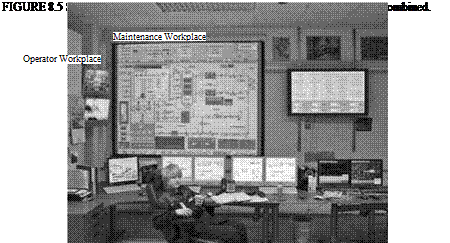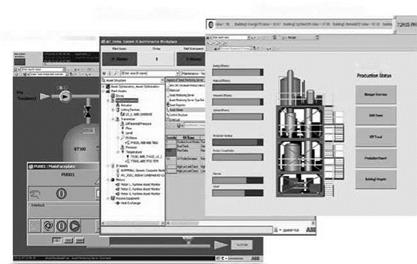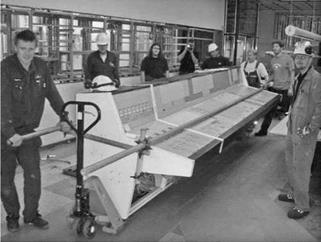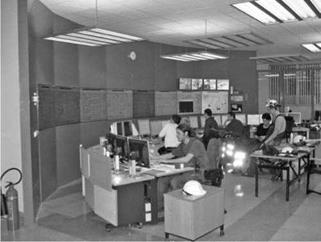Starting in 2004, a major rebuild was carried out at a pulp and paper mill, Korsnas, in Gavle, Sweden. The company closed thirteen control rooms and replaced these with only two new control rooms. At the same time, the staff was reorganised so that the complete production process became the responsibility of only one production team. Similarly, only one manager was responsible for the complete production
![]()
 |
 Building 3
Building 3
FIGURE 8.6 Personalised workplace with filtered information.
process. Functional departments were replaced. So instead of having departments with control engineering, maintenance department, and so forth, these functions were integrated in the new production team for the fibre line, and respectively the paper mill and the recovery area. The production teams directed how the operations should be performed by all shifts. This avoided the problem of different shift teams operating in different ways. In this new way of working, the goal is to identify the best possible way and then every team should follow that direction.
In 2005, Billerud, an integrated pulp and paper mill located in the town of Skarblacka in southwest Sweden, rebuilt its power plant. Using a Distributed Control
System (DCS) from Siemens, Billerud reconfigured its control rooms in a similar manner to those at ABB. The emphasis is on clear, unambiguous process data. Now, data can be displayed on large display screens to complement the data displayed on smaller monitors. As necessary, the operators can view data from different perspectives and with different emphasis. Operators can also combine their specialised knowledge in collaborative working and decision making. At Billerud, the process displays are configured in a slightly different layout, but otherwise the structure is similar. Other, but alike examples are shown in Figure 8.7 and Figure 8.8.
|
FIGURE 8.7 Old control panels are removed from the Malarenergi control room. |
|
FIGURE 8.8 After the rebuild in 2005, the new control room has a combination of large displays on the wall and a number of small screens for the operators. |
As shown in the figures, the operators have an overview picture of the plant on the large screen and to the right there is the alarm list displayed on such a scale that it is easy for the operators to read. The small screens display details of the process. Operators choose between the two types of displays as appropriate. As in the case with the ABB system, there is no possibility for an operator to walk in between the small screens and the large screens and restrict the view of colleagues.
Malarenergi is a power company with its central power production plant in Vasteras, Sweden. In 2005 Malarenergi made a major revision of the plant control room. The DCS system is primarily an ABB Advant system, although older versions also exist. Until 2005, Malarenergi also used the old ‘pulpit’ type of controls with hard-wired controls and displays in parallel to the more modern computerised controls. As part of its plant upgrade, Malarenergi modernised its control room to give a common working environment for the operators and process engineers. At the same time, the hardware types of displays were removed, as shown in Figure 8.7. Instead the designers installed a combination of large screens and small displays. This new configuration gave the operators a much more modern environment according to guidelines recommended by ABB. Here each operator station has four screens kept together, as seen in Figure 8.9.
After the project manager at Malarenergi and his team had gained experience with the new system, he summarised its advantages and disadvantages. The advantages of the new control room and the new computer system are:
1. The hardware has much higher capacity.
2. All parts of the process and all systems have the same layout, which makes it easier to recognise what is happening.
3. You can work only in a Windows environment and do not need to keep up with UNIX, OPEN-VMS, or other platforms any more.
|
FIGURE 8.9 Each operator workstation has four screens to see both overview and detail. |
4. The new aspect system introduced by ABB makes it easy to find different types of information for specific equipment or parts of the process without having to navigate from far away.
5. You have direct access to the Internet and other online resources.
6. You have a major possibility to customise your own displays with the information you really need.
Disadvantages with the new system compared to the old pulpit system are:
1. Every time there is a new version of software, for example, there is a need for upgrading. This was not needed before the controls were computerised.
2. The software solutions are probably more sensitive compared to the old hardware solutions, although the software solutions also have many new features.
3. You need to make lots of movements of the mouse to navigate the display system.
4. Some of the older operators find it more difficult to learn the new system with more functions
5. The overview of the process is not as good as with the pulpit system.
Even if there are some drawbacks with the new computer-based systems, it is also obvious that the functionality is much higher. New types of functions for advanced diagnostics and control can be implemented. Also, with the large screens on the wall, the overview is significantly better than when there were only small screens on desks.






